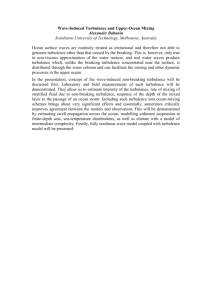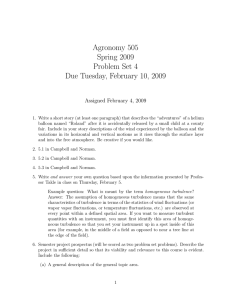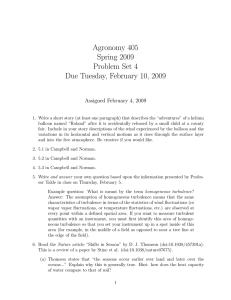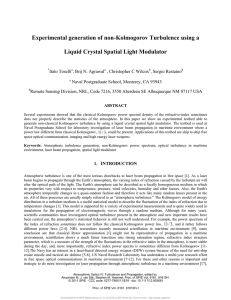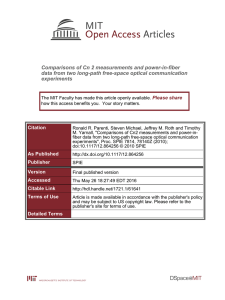M -
advertisement
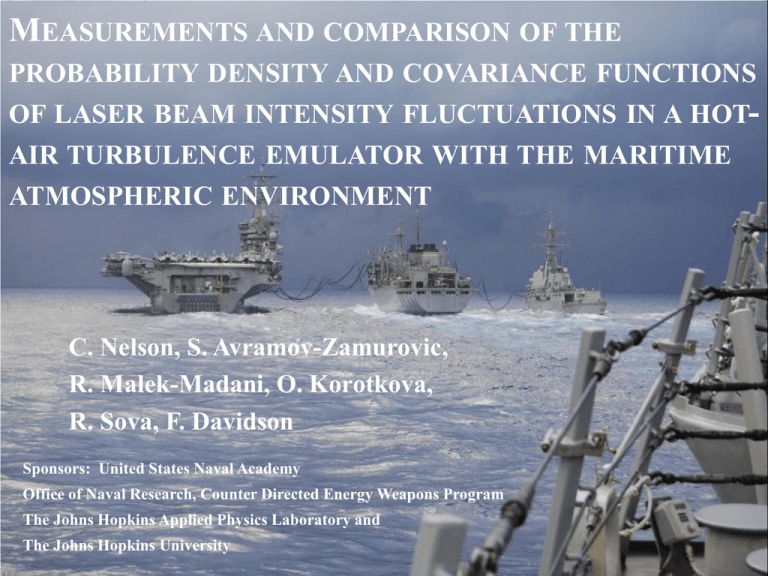
MEASUREMENTS AND COMPARISON OF THE PROBABILITY DENSITY AND COVARIANCE FUNCTIONS OF LASER BEAM INTENSITY FLUCTUATIONS IN A HOTAIR TURBULENCE EMULATOR WITH THE MARITIME ATMOSPHERIC ENVIRONMENT C. Nelson, S. Avramov-Zamurovic, R. Malek-Madani, O. Korotkova, R. Sova, F. Davidson Sponsors: United States Naval Academy Office of Naval Research, Counter Directed Energy Weapons Program The Johns Hopkins Applied Physics Laboratory and The Johns Hopkins University FIELD TESTS – OVERVIEW Field Tests off of Atlantic Coast and at USNA 5 – 18 km optical horizon off of Atlantic Coast and 650 m at USNA Movie Clip Turbulence Generator Mk I, Mod 0 Photo looking down through turbulence generator, daughter Aurora pictured INITIAL TURBULENCE EMULATOR THEORY High delta T High Cn2 Hot and cool air meet and mix Red Oak, aluminum flashing, modular RESULTS Heat On Heat Off Cn2 ~10-9 m-2/3, σI2 ~ 0.02 – 0.05, σR2 ~0.1 - 0.7 Initial design showed some positive results/proof of concept 2ND TURBULENCE EMULATOR MOD 0 TO THE MOD 1 TE COMPARISON WITH FIELD TESTS 1550 nm, 10 cm Tx, closed loop, AO, 10.7 km, Nf = 0.2 CMOS, HeNe, Stat. SLM, HeNe, 650 m, Expander, Nf = 0.04 1.6 mm dia. 1550 nm fiber coll., no AO, Nf = 0.2 Fiber coll., 1550 nm pol., exp., SLM, Mech. IRIS, Nf = 0.04 Modified set-ups (𝛽𝛽 −1) 𝑊𝑊𝐺𝐺𝐺𝐺 (𝐼𝐼 ) = 𝑊𝑊𝑔𝑔 (𝐼𝐼 ) ∑∞ 𝑛𝑛=0 𝑊𝑊𝑛𝑛 𝐿𝐿𝑛𝑛 THEORY • Gamma-Laguerre (GL) Medium and source independent Uses first n moments Gamma-Gamma (GG) Source, medium dependent Uses first two moments Lognormal (LN) Classical weak turbulence model Temporal Autocovariance • • • • [ ][ ] • Bx (τ ) = Rx (τ ) − m 2 and Rx (τ ) = x (t1 ) x (t2 ) • B(exp fit ) (tdata ) = Ae ( − tdata / T1 ) (𝛽𝛽 −1) (−𝛽𝛽 /𝜇𝜇 )𝑘𝑘 ⟨𝐼𝐼 𝑘𝑘 ⟩ , 𝑘𝑘!(𝑛𝑛 −𝑘𝑘 )!𝛤𝛤(𝛽𝛽 +𝑘𝑘) (𝑥𝑥) = ∑𝑛𝑛𝑘𝑘=0 �𝑛𝑛 + 𝛽𝛽 − 1� 𝑛𝑛 − 1 1 2 exp �𝜎𝜎𝑙𝑙𝑙𝑙𝑙𝑙 �−1 , 𝛽𝛽 = 0.49𝜎𝜎𝐵𝐵2 𝑊𝑊𝐿𝐿𝐿𝐿 (𝐼𝐼 ) = 𝐼𝐼𝐼𝐼 • 2𝐿𝐿 𝑘𝑘𝑊𝑊02 1 1 2 �−1 exp �𝜎𝜎𝑙𝑙𝑙𝑙𝑙𝑙 12 [1+0.56 (1+𝜗𝜗 )𝜎𝜎𝐵𝐵5 ]7/6 𝜗𝜗 = [1 + ( • 𝑘𝑘! 𝛼𝛼 +𝛽𝛽 𝜎𝜎𝐵𝐵2 = (⟨𝐼𝐼2 ⟩ − ⟨𝐼𝐼⟩2 )/⟨𝐼𝐼⟩2 , • (−𝑥𝑥 )𝑘𝑘 2(𝛼𝛼𝛼𝛼 ) 2 𝛼𝛼 +𝛽𝛽 −1 𝐼𝐼 2 𝐾𝐾𝛼𝛼−𝛽𝛽 �2�𝛼𝛼𝛼𝛼𝛼𝛼�, 𝐼𝐼 𝛤𝛤 (𝛼𝛼 )𝛤𝛤 (𝛽𝛽 ) 2 𝜎𝜎𝑙𝑙𝑙𝑙𝑙𝑙 = • 𝐼𝐼 2 ⟩−⟨𝐼𝐼⟩2 ) 𝑊𝑊0 = 1, 𝑊𝑊1 = 𝑊𝑊2 = 0 𝐿𝐿𝑛𝑛 𝜇𝜇 ⟨𝐼𝐼⟩2 𝑊𝑊𝑛𝑛 = 𝑛𝑛! 𝛤𝛤(𝛽𝛽) ∑𝑛𝑛𝑘𝑘=0 𝛼𝛼 = • Bx (t1 , t2 ) = x(t1 ) − x (t1 ) x (t2 ) − x (t2 ) 𝜇𝜇 = ⟨𝐼𝐼⟩, 𝛽𝛽 = (⟨ 𝑊𝑊𝐺𝐺𝐺𝐺 (𝐼𝐼) = • 𝛽𝛽𝛽𝛽 1 𝛽𝛽 𝛽𝛽 𝛽𝛽 −1 � 𝐼𝐼 exp (− ) � 𝜇𝜇 𝛤𝛤 (𝛽𝛽 ) 𝜇𝜇 𝑊𝑊𝑔𝑔 (𝐼𝐼) = 𝛽𝛽𝛽𝛽 � � , 𝐼𝐼 ≥ 0 2 𝑎𝑎𝑎𝑎𝑎𝑎 𝜎𝜎𝑙𝑙𝑙𝑙𝑙𝑙 = )2 ]−1 √2𝜋𝜋 𝑒𝑒𝑒𝑒𝑒𝑒 �− 𝜇𝜇 = ⟨ln (𝐼𝐼)⟩ 𝜎𝜎 2 = 𝑣𝑣𝑣𝑣𝑣𝑣(ln(𝐼𝐼 )) >0 0.51𝜎𝜎𝐵𝐵2 12 [1+0.69(1+𝜗𝜗 )𝜎𝜎𝐵𝐵5 ]5/6 [ln (𝐼𝐼 )−𝜇𝜇 ]2 2𝜎𝜎 2 � , 𝐼𝐼 > 0 TE COMPARISON WITH FIELD TEST A Atlantic Coast 2.54 cm PIF 0.64 cm PIB B TE C Combined PDFs Case Nf DS/ρ0 σI2 T1 # Fades 80/100 ms Ch. Avail. A 0.2 2 0.12 9.5 552 7/34 96.7% B 0.2 2 0.13 8.7 1717 1/31 96.4% C 0.2 1 0.13 1.2 1820 1/13 97.1% Similar PDFs, different Autocovariances Autocovariance could relate to overall length of fades DDet/ρ0 ratio might give information about overall # fades TE COMPARISON WITH FIELD TEST USNA CMOS A TE B Case Nf DS/ρ0 σI2 T1 # Fades 80/100 ms Ch. Avail. A 0.04 0.1 0.014 0.3 3384 1/1 96.5% B 0.04 0.1 0.014 1.5 2092 1/6 96.7% Similar PDFs, different Autocovariances Autocovariance could relate to overall length of fades DDet/ρ0 ratio might give information about overall # fades CONCLUSIONS/DISCUSSION Hot-air turbulence emulator showed a close comparison of σI2, Nf, and DS/ρ0 with a corresponding closeness in PDFs The 2nd order statistics through the temporal autocovariance function and T1 showed significant differences Having a smaller T1 could indicate shorter fade lengths A small Ddet/ρ0 ratio could indicate a higher number of fades REFERENCES [1] Mayer, K. J., Young, C. Y., “Effect of atmospheric spectrum models on scintillation in moderate turbulence,” J. Mod. Opt. 55, 1362-3044 (2008) [2] Barakat, R., “First-order intensity and log-intensity probability density functions of light scattered by the turbulent atmosphere in terms of lower-order moments,” J. Opt. Soc. Am. 16, 2269 (1999) [3] Korotkova, O., Avramov-Zamurovic, S., Malek-Madani, R., and Nelson, C., “Probability density function of the intensity of a laser beam propagating in the maritime environment,” Optics Express. Vol. 19, No. 21, (2011) [4] Al-Habash, M. A., Andrews, L. C., and Phillips, R. L., “Mathematical model for the irradiance probability density function of a laser beam propagating through turbulent media,” Opt. Eng. 40, 1554-1562 (2001) [5] Andrews, L. C., Phillips, R. L., and Hopen, C. Y., [Laser Beam Scintillation with Applications], SPIE Press, Bellingham, WA, (2001). [6] Aitchison, J. and Brown, J. A. C., [The Lognormal Distribution], Cambridge University Press, (1957) [7] Lyke, S. D., Voelz, D. G., and Roggemann, M. C., “Probability density of aperture-averaged irradiance fluctuations for long range free space optical communication links,” Applied Optics Vol. 48, No. 33, (2009) [8] Wayne, D. T., Phillips, R. L., Andrews, L. C., Leclerc, T., Sauer, P., Stryjewski, J., “Comparing the Log-Normal and Gamma-Gamma Model to Experimental Probability Density Functions of Aperture Averaging Data,” Proc. SPIE 7814, (2010) [9] Andrews, L. C., and Phillips, R. L., [Laser Beam Propagation through Random Media, 2nd edition], SPIE Press, Bellingham, WA, (2005). [10] Pratap, R., [Getting Started with MATLAB 7, a Quick Introduction for Scientists and Engineers], Oxford University Press, (2006). [11] Juarez, J. C., Sluz, J. E., Nelson, C., Airola, M. B., Fitch, M. J., Young, D. W., Terry, D., Davidson, F. M., Rottier, J. R., and Sova, R. M., “Free-space optical channel characterization in the maritime environment,” SPIE Conference presentation, (2010) [12] J.C. Juarez, J. E. Sluz, C. Nelson, M. B. Airola, M. J. Fitch, D. W. Young, D. Terry, F. M. Davidson, J. R. Rottier, and R. M. Sova, “Free-space optical channel characterization in the maritime environment,” Proc. SPIE 7685, (2010) [13] Korotkova, O., Avramov-Zamurovic, S., Nelson, C., Malek-Madani, R., “Probability density function of partially coherent beams propagating in the atmospheric turbulence,” Proc. SPIE 8238, (2012) [14] [14] Nelson, C., Avramov-Zamurovic, S., Korotkova, O., Malek-Madani, R., Sova, R., Davidson, F., “Probability density function computations for power-in-bucket and power-in-fiber measurements of an infrared laser beam propagating in the maritime environment,” Proc. SPIE 8038, (2011) [15] Goodman, J. W., [Introduction to Fourier Optics, 2nd edition], McGraw-Hill Co. Inc., (1996). [16] Gamo, H., and Majumdar, A., “Atmospheric turbulence chamber for optical transmission experiment: characterization by thermal method,” Applied Optics Vol. 17, No. 23, 3755-3762 (1978) [17] Phillips, J. D., “Atmospheric Turbulence Simulation Using Liquid Crystal Spatial Light Modulators,” Air Force Institute of Technology Masters Thesis, (2005)



